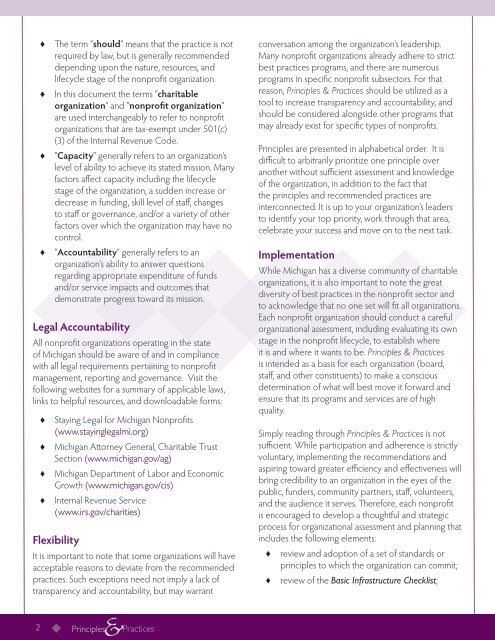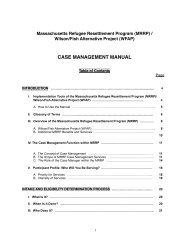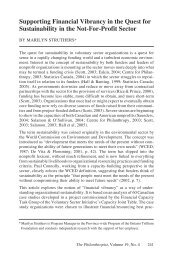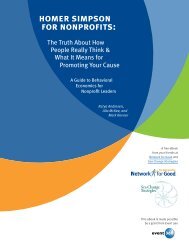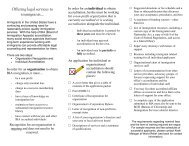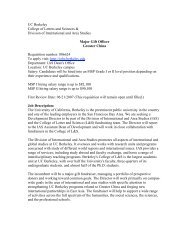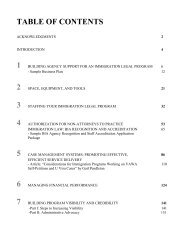Principles & Practices for Nonprofit - NNAAC
Principles & Practices for Nonprofit - NNAAC
Principles & Practices for Nonprofit - NNAAC
You also want an ePaper? Increase the reach of your titles
YUMPU automatically turns print PDFs into web optimized ePapers that Google loves.
♦ The term “ should” means that the practice is not<br />
required by law, but is generally recommended<br />
depending upon the nature, resources, and<br />
lifecycle stage of the nonprofit organization.<br />
♦ In this document the terms “ charitable<br />
organization” and “nonprofit organization”<br />
are used interchangeably to refer to nonprofit<br />
organizations that are tax-exempt under 501(c)<br />
(3) of the Internal Revenue Code.<br />
♦ “ Capacity” generally refers to an organization’s<br />
level of ability to achieve its stated mission. Many<br />
factors affect capacity including the lifecycle<br />
stage of the organization, a sudden increase or<br />
decrease in funding, skill level of staff, changes<br />
to staff or governance, and/or a variety of other<br />
factors over which the organization may have no<br />
control.<br />
♦ “ Accountability” generally refers to an<br />
organization’s ability to answer questions<br />
regarding appropriate expenditure of funds<br />
and/or service impacts and outcomes that<br />
demonstrate progress toward its mission.<br />
Legal Accountability<br />
All nonprofit organizations operating in the state<br />
of Michigan should be aware of and in compliance<br />
with all legal requirements pertaining to nonprofit<br />
management, reporting and governance. Visit the<br />
following websites <strong>for</strong> a summary of applicable laws,<br />
links to helpful resources, and downloadable <strong>for</strong>ms:<br />
♦<br />
♦<br />
♦<br />
♦<br />
Staying Legal <strong>for</strong> Michigan <strong>Nonprofit</strong>s<br />
(www.stayinglegalmi.org)<br />
Michigan Attorney General, Charitable Trust<br />
Section (www.michigan.gov/ag)<br />
Michigan Department of Labor and Economic<br />
Growth (www.michigan.gov/cis)<br />
Internal Revenue Service<br />
(www.irs.gov/charities)<br />
Flexibility<br />
It is important to note that some organizations will have<br />
acceptable reasons to deviate from the recommended<br />
practices. Such exceptions need not imply a lack of<br />
transparency and accountability, but may warrant<br />
2<br />
& <strong>Principles</strong> <strong>Practices</strong><br />
conversation among the organization’s leadership.<br />
Many nonprofit organizations already adhere to strict<br />
best practices programs, and there are numerous<br />
programs in specific nonprofit subsectors. For that<br />
reason, <strong>Principles</strong> & <strong>Practices</strong> should be utilized as a<br />
tool to increase transparency and accountability, and<br />
should be considered alongside other programs that<br />
may already exist <strong>for</strong> specific types of nonprofits.<br />
<strong>Principles</strong> are presented in alphabetical order. It is<br />
difficult to arbitrarily prioritize one principle over<br />
another without sufficient assessment and knowledge<br />
of the organization, in addition to the fact that<br />
the principles and recommended practices are<br />
interconnected. It is up to your organization’s leaders<br />
to identify your top priority, work through that area,<br />
celebrate your success and move on to the next task.<br />
Implementation<br />
While Michigan has a diverse community of charitable<br />
organizations, it is also important to note the great<br />
diversity of best practices in the nonprofit sector and<br />
to acknowledge that no one set will fit all organizations.<br />
Each nonprofit organization should conduct a careful<br />
organizational assessment, including evaluating its own<br />
stage in the nonprofit lifecycle, to establish where<br />
it is and where it wants to be. <strong>Principles</strong> & <strong>Practices</strong><br />
is intended as a basis <strong>for</strong> each organization (board,<br />
staff, and other constituents) to make a conscious<br />
determination of what will best move it <strong>for</strong>ward and<br />
ensure that its programs and services are of high<br />
quality.<br />
Simply reading through <strong>Principles</strong> & <strong>Practices</strong> is not<br />
sufficient. While participation and adherence is strictly<br />
voluntary, implementing the recommendations and<br />
aspiring toward greater efficiency and effectiveness will<br />
bring credibility to an organization in the eyes of the<br />
public, funders, community partners, staff, volunteers,<br />
and the audience it serves. There<strong>for</strong>e, each nonprofit<br />
is encouraged to develop a thoughtful and strategic<br />
process <strong>for</strong> organizational assessment and planning that<br />
includes the following elements:<br />
♦<br />
review and adoption of a set of standards or<br />
principles to which the organization can commit;<br />
♦ review of the Basic Infrastructure Checklist;


